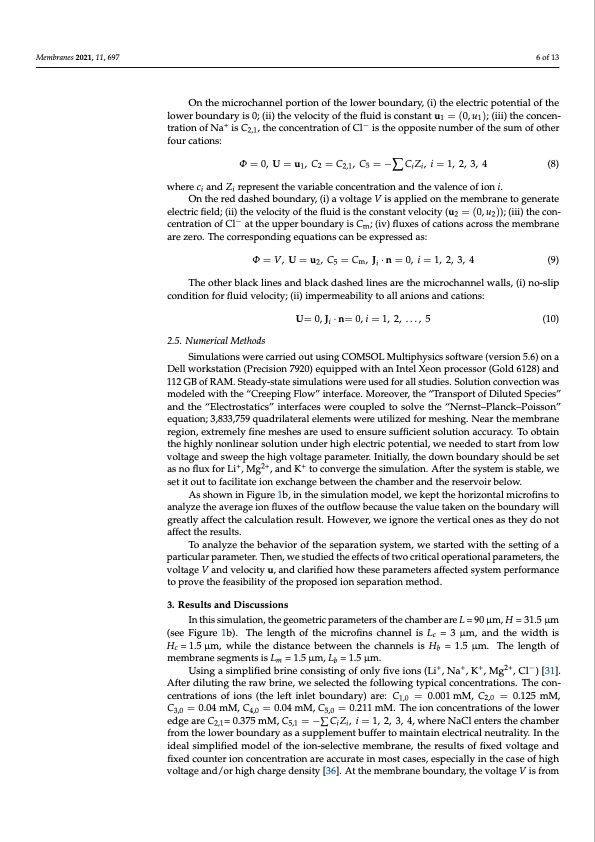
PDF Publication Title:
Text from PDF Page: 006
Membranes 2021, 11, 697 6 of 13 On the microchannel portion of the lower boundary, (i) the electric potential of the lower boundary is 0; (ii) the velocity of the fluid is constant u1 = (0, u1 ); (iii) the concen- tration of Na+ is C2,1, the concentration of Cl− is the opposite number of the sum of other four cations: Φ=0, U=u1, C2 =C2,1, C5 =−∑CiZi, i=1, 2, 3, 4 (8) where ci and Zi represent the variable concentration and the valence of ion i. On the red dashed boundary, (i) a voltage V is applied on the membrane to generate electric field; (ii) the velocity of the fluid is the constant velocity (u2 = (0, u2 )); (iii) the con- centration of Cl− at the upper boundary is Cm; (iv) fluxes of cations across the membrane are zero. The corresponding equations can be expressed as: Φ = V, U = u2, C5 = Cm, Ji · n = 0, i = 1, 2, 3, 4 (9) The other black lines and black dashed lines are the microchannel walls, (i) no-slip condition for fluid velocity; (ii) impermeability to all anions and cations: U= 0, Ji · n= 0, i = 1, 2, . . . , 5 (10) 2.5. Numerical Methods Simulations were carried out using COMSOL Multiphysics software (version 5.6) on a Dell workstation (Precision 7920) equipped with an Intel Xeon processor (Gold 6128) and 112 GB of RAM. Steady-state simulations were used for all studies. Solution convection was modeled with the “Creeping Flow” interface. Moreover, the “Transport of Diluted Species” and the “Electrostatics” interfaces were coupled to solve the “Nernst–Planck–Poisson” equation; 3,833,759 quadrilateral elements were utilized for meshing. Near the membrane region, extremely fine meshes are used to ensure sufficient solution accuracy. To obtain the highly nonlinear solution under high electric potential, we needed to start from low voltage and sweep the high voltage parameter. Initially, the down boundary should be set as no flux for Li+, Mg2+, and K+ to converge the simulation. After the system is stable, we set it out to facilitate ion exchange between the chamber and the reservoir below. As shown in Figure 1b, in the simulation model, we kept the horizontal microfins to analyze the average ion fluxes of the outflow because the value taken on the boundary will greatly affect the calculation result. However, we ignore the vertical ones as they do not affect the results. To analyze the behavior of the separation system, we started with the setting of a particular parameter. Then, we studied the effects of two critical operational parameters, the voltage V and velocity u, and clarified how these parameters affected system performance to prove the feasibility of the proposed ion separation method. 3. Results and Discussions In this simulation, the geometric parameters of the chamber are L = 90 μm, H = 31.5 μm (see Figure 1b). The length of the microfins channel is Lc = 3 μm, and the width is Hc = 1.5 μm, while the distance between the channels is Hb = 1.5 μm. The length of membrane segments is Lm = 1.5 μm, Lb = 1.5 μm. Using a simplified brine consisting of only five ions (Li+, Na+, K+, Mg2+, Cl−) [31]. After diluting the raw brine, we selected the following typical concentrations. The con- centrations of ions (the left inlet boundary) are: C1,0 = 0.001 mM, C2,0 = 0.125 mM, C3,0 = 0.04 mM, C4,0 = 0.04 mM, C5,0 = 0.211 mM. The ion concentrations of the lower edge are C2,1= 0.375 mM, C5,1 = −∑ CiZi, i = 1, 2, 3, 4, where NaCl enters the chamber from the lower boundary as a supplement buffer to maintain electrical neutrality. In the ideal simplified model of the ion-selective membrane, the results of fixed voltage and fixed counter ion concentration are accurate in most cases, especially in the case of high voltage and/or high charge density [36]. At the membrane boundary, the voltage V is fromPDF Image | Brines Based on Free Flow Ion Concentration Polarization

PDF Search Title:
Brines Based on Free Flow Ion Concentration PolarizationOriginal File Name Searched:
membranes-11-00697-v2.pdfDIY PDF Search: Google It | Yahoo | Bing
Product and Development Focus for Infinity Turbine
ORC Waste Heat Turbine and ORC System Build Plans: All turbine plans are $10,000 each. This allows you to build a system and then consider licensing for production after you have completed and tested a unit.Redox Flow Battery Technology: With the advent of the new USA tax credits for producing and selling batteries ($35/kW) we are focussing on a simple flow battery using shipping containers as the modular electrolyte storage units with tax credits up to $140,000 per system. Our main focus is on the salt battery. This battery can be used for both thermal and electrical storage applications. We call it the Cogeneration Battery or Cogen Battery. One project is converting salt (brine) based water conditioners to simultaneously produce power. In addition, there are many opportunities to extract Lithium from brine (salt lakes, groundwater, and producer water).Salt water or brine are huge sources for lithium. Most of the worlds lithium is acquired from a brine source. It's even in seawater in a low concentration. Brine is also a byproduct of huge powerplants, which can now use that as an electrolyte and a huge flow battery (which allows storage at the source).We welcome any business and equipment inquiries, as well as licensing our turbines for manufacturing.| CONTACT TEL: 608-238-6001 Email: greg@infinityturbine.com | RSS | AMP |